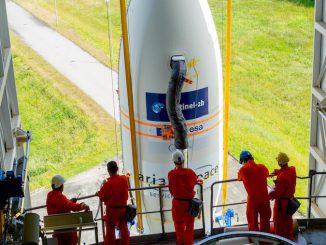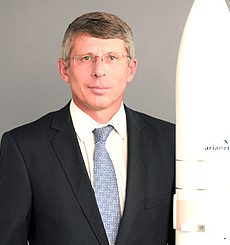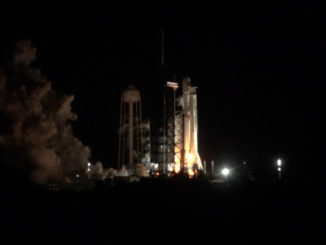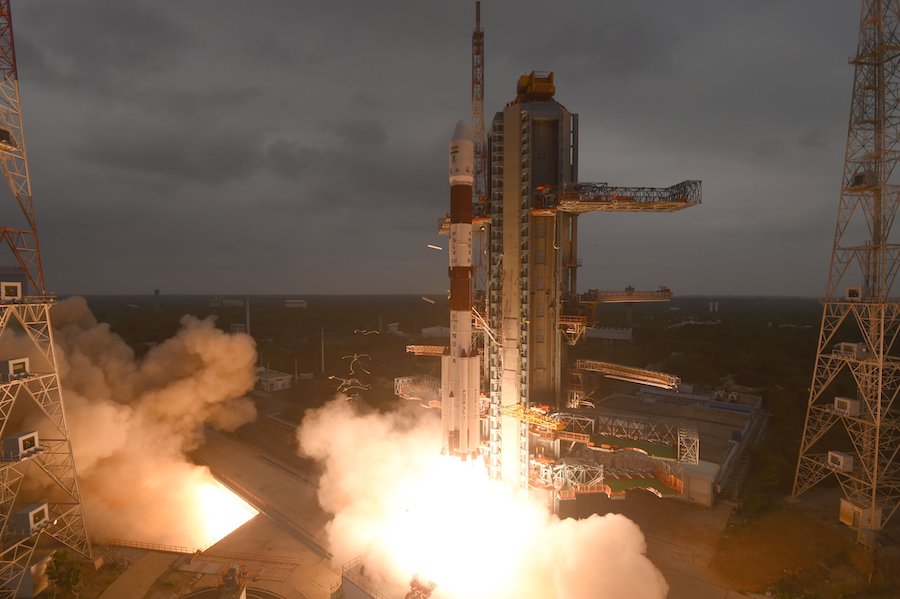
Thirteen U.S.-built nanosatellites hitched a ride to space Tuesday with a sharp-eyed Indian Earth-imaging observatory at the top of a Polar Satellite Launch Vehicle.
India’s Cartosat 3 mapping satellite, 12 commercial SuperDove CubeSats, and an experimental tech demo nanosatellite rode the PSLV into orbit following a fiery blastoff from the Satish Dhawan Space Center at 10:58 p.m. EST Tuesday (0358 GMT Wednesday).
The 144-foot-tall (44.4-meter) rocket, powered by four stages and six strap-on solid rocket boosters, arced toward the southeast from the launch base on India’s southeast coast. A few minutes later, the rocket turned south in a “dogleg” maneuver to steer around Sri Lanka, avoiding flying over the island nation.
Within a half-hour, the PSLV injected its 14 satellite payloads into a polar orbit more 316 miles (509 kilometers) above Earth. Cameras fixed to the PSLV’s fourth stage showed the 14 spacecraft separating from the rocket, and officials from the Indian Space Research Organization — India’s space agency — declared the launch a success.
“Cartosat 3 is (India’s) highest-resolution civilian spacecraft,” said K. Sivan, ISRO’s chairman. “It is also the most complex and advanced Earth observation satellite ISRO has built so far.”
The 3,582-pound (1,625-kilogram) Cartosat 3 spacecraft carries an optical imaging payload with a resolution of about 25 centimeters — less than a foot — allowing analysts to identify types of cars and see finer details in buildings and natural landforms.
“The realization of Cartosat 3 has witnessed a totally new development in advanced technological areas, across the board, in all the domains from the payload to the communications system, the optical system, and the sensors, and so on,” said P. Kunhikrishnan, head of ISRO’s U.R. Rao Satellite Center.
Cartosat 3 will provide imagery with “the highest-ever achieved spatial resolution of about a foot, combined with a much wider swath,” Kunhikrishnan said. “That demanded a very high data throughout.”
The Cartosat 3 satellite will downlink imagery through a high-bandwidth Ka-band data link, Kunhikrishnan said.
India has launched nine Cartosat mapping satellites since 2005, the first of which had an imaging resolution of 8.2 feet, or 2.5 meters. The Cartosat satellites launched since 2005 have offered improvements in resolution and data collection capacity.
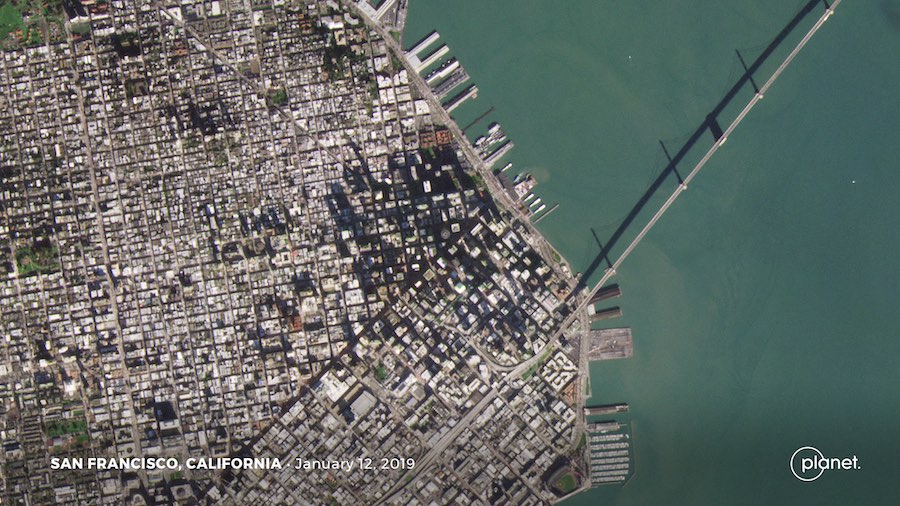
Twelve of the secondary passengers that launched with the PSLV Tuesday are owned by Planet, a San Francisco-based company that operates more than 100 shoebox-sized “Dove” CubeSats with Earth-imaging cameras. Planet, which builds its own spacecraft, says the 12 satellites launching on the PSLV are part of an upgraded series of Earth-observing nanosatellites called “SuperDoves.”
“New sensors are enabling higher image quality with sharper, more vibrant colors and accurate surface reflectance values for advanced algorithms and time-series analysis,” Planet said last month when the company announced the new SuperDove capabilities.
The SuperDove satellites will join 26 SuperDove prototypes already in orbit, according to Planet.
Planet sells 3-meter (10-foot) resolution imagery from its Dove satellites through a service named PlanetScope. The company’s large fleet of small, relatively inexpensive satellites can provide global images refreshed daily, enabling customers ranging from farmers to the U.S. government’s spy agencies to look for day-to-day changes.
The new SuperDove satellites will allow Planet to collect imagery in four, five and eight spectral bands, yielding up to five times more data than the earlier Dove satellites, according to Will Marshall, Planet’s founder and CEO. The upgrades are particularly useful for agricultural and pollution monitoring.
With Tuesday’s launch, Planet has launched more than 400 satellites.
Sarah Bates, a Planet spokesperson, said Monday that the company currently has roughly 120 operational Dove nanosatellites in orbit. Planet has also launched larger refrigerator-sized 15 SkySat satellites, which offer higher-resolution imagery than the Dove CubeSats, and the company inherited five satellites from RapidEye when it acquired that company in 2013.
In addition to more SuperDove CubeSats, Planet has six more SkySat satellites in production and plans to launch them within the next year, Bates said.
Planet said its ground team received signals from all 12 satellites launched Tuesday. The company’s newest batch of SuperDove satellites is designated Flock 4p.
The Flock 4p satellites will undergo detumbling maneuvers, various subsystem health checks, solar panel deployments, and calibration of their imagery systems before entering commercial service, according to Planet.
A three-unit CubeSat named Meshbed also rode India’s PSLV into orbit. The Meshbed nanosatellite, owned by Analytical Space of Cambridge, Massachusetts, will test an experimental phased array antenna developed by MITRE, a not-for-profit company that works with U.S. government research centers to develop innovations in defense and intelligence, aviation, health care and cybersecurity applications, among other areas.
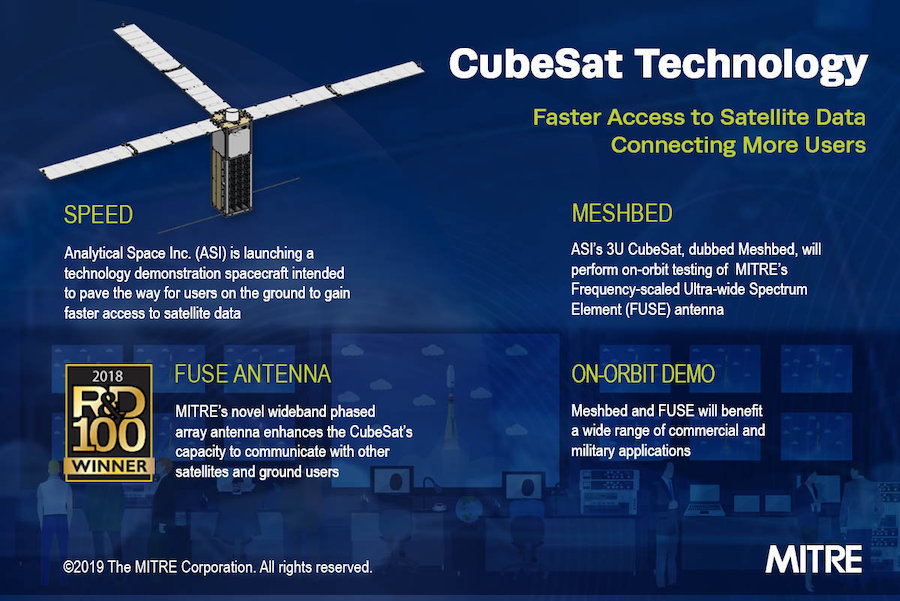
MITRE’s patented Frequency-scaled Ultra-wide Spectrum Element, or FUSE, antenna could help enable the faster relay of satellite data to ground users, according to Analytical Space. The demonstration of the FUSE antenna, which MITRE developed in partnership with the Naval Research Laboratory, could also aid future U.S. government satellite missions in tactical communication and reconnaissance, officials said.
Built with 3D-printed parts, the FUSE antenna will unfurl from the Meshbed CubeSat after launch, then begin a series of data relay demonstrations.
“By solving the problem of fitting a wideband antenna into a CubeSat and demonstrating that it can operate in the harsh space environment, FUSE will accelerate the development of high-performance and multi-function systems, with a wide range of applications that includes military use and commercial satellite communications,” Analytical Space said.
The launch bookings for the Planet SuperDove satellites and the Meshbed CubeSat were arranged with NewSpace India Ltd., the commercial arm of ISRO. Spaceflight, a Seattle-based company, was the launch broker for Analytical Space’s Meshbed satellite.
Email the author.
Follow Stephen Clark on Twitter: @StephenClark1.

